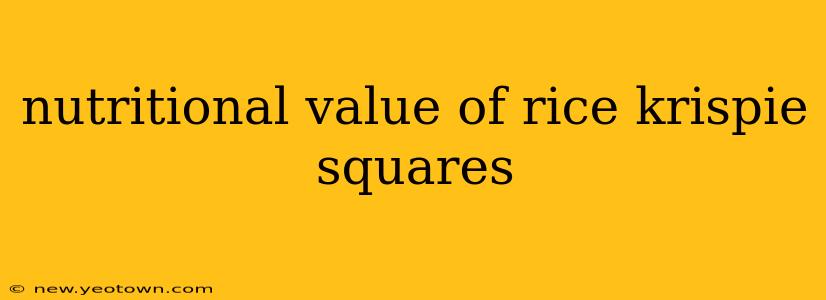The Surprising Nutritional Value (or Lack Thereof) of Rice Krispie Squares: A Sweet Treat Under the Microscope
Let's be honest, Rice Krispie Squares aren't exactly known for being health food. They're the quintessential childhood treat, a nostalgic reminder of simpler times, school bake sales, and gooey, sugary goodness. But what's actually in those delightful squares? Let's delve into the nutritional value (or lack thereof) and uncover some surprising facts.
Our story begins with the humble Rice Krispie, a puffed rice cereal that forms the base of this beloved snack. While rice itself provides some carbohydrates and a tiny bit of fiber, the process of puffing transforms it into a largely refined carbohydrate source. This means the nutritional density isn't exactly high to begin with.
Then we add the marshmallow, the glue that holds the whole thing together. Marshmallows are essentially sugar, corn syrup, and gelatin. This brings a significant sugar rush and very little else in terms of essential nutrients. The butter (or margarine) adds fat, primarily saturated fat, contributing to the rich, creamy texture but not to its overall health profile.
So, what are we left with? A treat that's high in carbohydrates, sugar, and fat, and relatively low in vitamins, minerals, and fiber. It's a classic example of an energy-dense food, providing calories but not much in the way of essential nutrients.
What are the main ingredients in Rice Krispie Treats?
The core ingredients are simple: Rice Krispies cereal, marshmallows, and butter. Variations may include additional ingredients like chocolate chips, sprinkles, or extracts, which further alter the nutritional content, often adding more sugar and fat. It's crucial to check the specific recipe or product packaging for the most accurate nutritional information.
Are Rice Krispie Treats a good source of any vitamins or minerals?
No, Rice Krispie Treats are not a significant source of vitamins or minerals. The primary ingredients are refined carbohydrates, sugar, and fat, which lack the vitamins and minerals found in whole, unprocessed foods. For essential nutrients, you'd be better off reaching for fruits, vegetables, whole grains, and lean proteins.
How many calories are in a typical Rice Krispie Square?
The calorie count varies significantly depending on the size of the square and the recipe. A typical homemade Rice Krispie square can range from 100-150 calories, while store-bought variations may have slightly different calorie counts. It's always best to check the nutrition label on the packaging for accurate information.
Can I make healthier Rice Krispie Squares?
While it's difficult to make Rice Krispie Squares truly "healthy," there are ways to make them slightly better. Using whole-grain puffed rice cereal instead of the traditional Rice Krispies can add a bit more fiber. Reducing the amount of sugar and butter can also decrease the overall calorie and fat content. However, even with these modifications, they will still remain a treat best enjoyed in moderation.
What are some healthier alternatives to Rice Krispie Squares?
If you're looking for a healthier snack, there are plenty of delicious alternatives. Fruits, vegetables, yogurt, nuts, and seeds are all excellent choices that offer a variety of nutrients and fiber. Homemade granola bars made with whole grains, nuts, and seeds are a fantastic option to satisfy that sweet and crunchy craving.
In conclusion, while Rice Krispie Squares hold a special place in many hearts (and stomachs), they're not exactly a nutritional powerhouse. They are a delightful indulgence to be enjoyed occasionally, not as a regular part of a healthy diet. Remember, moderation is key! Enjoy them mindfully as a treat, and prioritize nutrient-rich foods for the majority of your meals.

